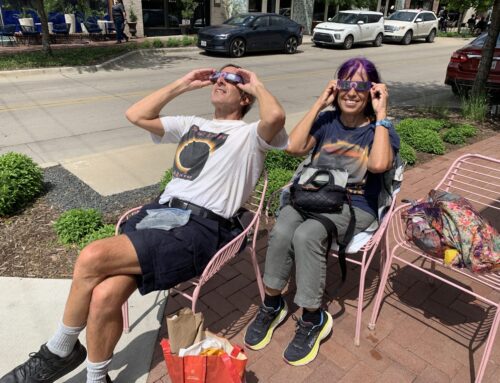Sophia Rodriguez had been living in her Oak Cliff home in the Clarendon Westmoreland neighborhood for a year or two when she noticed a few feral cats roaming in 2013.
In an attempt to be a good neighbor, Rodriguez trapped the cats and took them to Dallas Animal Services to be neutered before returning them to the streets.
Nonetheless, 10 years later, Rodriguez says her neighborhood has become “overrun” by stray cats, and resources for those who want to help have dwindled.
“Now as I walk up and down the block, I see kittens everywhere,” Rodriguez says. “We didn’t see overpopulation of kittens or even dogs, but I’ve noticed since (COVID-19) … we’re seeing overpopulation.”
Across Dallas, many neighborhoods are seeing a surge in stray dogs and cats roaming the streets.
You’ve likely seen the dogs running along hot streets unleashed, untagged, unchipped. Every other post on the Nextdoor app seems to be a post looking to rehome a dog, a post about a found dog, or a post about the number of dogs overpopulating shelters and rescues.
In apartment complexes, residential areas and restaurant hubs, feral cats — which once were fondly seen as an adorable method of pest control — now roam in packs and reproduce faster than anyone can keep track.
According to Dallas animal activists and Dallas Animal Services, it’s a problem that can no longer be ignored.
And one that will be difficult to solve.
Population problems
Shelters usually see a surge in population during the summer months, says Amanda Atwell, spokesperson for Dallas Animal Services.
It was especially true this summer, as DAS’s shelter on Westmoreland Road struggled to keep up with the dog population, which hovered around 140% capacity for weeks on end.
The 300-kennel shelter regularly had around 400 dogs, leading to dogs being doubled up in kennels, makeshift kennels being erected in hallways, a decreased ability to take in strays and an increase in euthanizations.
While the shelter saw anywhere from 10 to 40 adoptions a day, its daily intake was nearly always double that.
“The issue that we’re having is not something that is going to be solved overnight. It’s going to take weeks of just having more positive outcomes than we have animals come to our shelter,” Atwell says.
Large dog breeds such as German Shepherds, or breeds that have been historically labeled as aggressive such as pit bulls, are most common at the shelter.
“People just don’t want big dogs right now, and so part of the issue is finding the market for those big dogs,” Atwell says.
Atwell says a rise in housing costs, which has led to more people renting, has contributed to fewer people taking in large dogs, restricted breeds or multiple dogs.
In a June briefing to the Quality of Life, Arts & Culture committee, Dallas Animal Services said the department was experiencing a staffing deficit of 21%.
According to Atwell, those shortages are not in the animal care department and have not impacted the shelter’s ability to care for the animals in its population.
But Rodriguez says the summer’s strain was obvious when she went to the DAS shelter in mid-July with two “bitty little” kittens that had been abandoned near her home. She and her daughter decided to care for them after it was clear one was struggling in the summer heat.
But when Rodriguez’s daughter took the cats to the shelter, she says an employee did not evaluate the cats before sending her away. Rodriguez returned the next day with the kitten, who was at that point “near death,” and was told it would be euthanized because of a lack of space in the shelter and the cat’s failing health.
“I felt like if they’d taken him in (the day before), maybe he would have had a better chance. But now he was basically dying. Like, he looked like he was suffering at this point,” Rodriguez says.
The experience stood in stark contrast with the one she’d had 10 years prior, bringing in feral cats to be neutered as part of a trap, nurture and release program. While the program still operates, Rodriguez says she has noticed it is not as robust as it once was and her neighbors have begun turning to shelters in neighboring cities.
The cat population at the shelter fluctuates but hovered around 30%-40% in the later months of summer, Atwell says.
The DAS shelter does have a cat NICU for infant cats that have been abandoned, but Atwell says the shelter generally encourages the public to leave kittens outside and wait for a mother to return for the “best chance of life.”
“We’ve looked at studies, and community cats are able to thrive without being a nuisance. We will take them in and spay or neuter them, and then we release them into the population,” Atwell says.
Fostering a found dog
Rescues are also feeling the burden of the number of stray dogs in Dallas.
According to Leslie Sans, founder and executive director of Dallas Pets Alive!, the rescue group is experiencing the largest dog population since pre-COVID.
Dallas Pets Alive! is a foster-based group that aims to pull medically or behaviorally needy dogs from the DAS shelter, but Sans says she has been unable to find the number of foster families necessary to field the number of dogs the rescue wants to help.
“I need fosters and I need adopters more than ever before to step up and to choose to open their homes to these animals in need so the shelters can take in the strays that don’t have a place to go,” Sans says. “But right now they have to have an outlet to create that space.”
Dallas Pets Alive!’s intake inquiries from community members who find a stray or are looking to rehome their pet have increased 50% since summer 2022.
Sans says that the high number of inquiries led the organization to emphasize the Positive Alternatives to Shelter Surrender, or PASS, program. Through the program, the rescue is able to support anyone who may have found a stray and is willing to foster it instead of taking it to the shelter.
Junius Heights resident Amanda Wiltz says the program was a “lifesaver” for her family after they took in a German Shepherd that had been found roaming around Preston Road and Northwest Highway.
Preston, the German Shepherd, was not used to being inside a home, went through toys and food “like crazy” and exhibited other behavioral challenges that led Wiltz to look into fostering him until a permanent home could be found. Through the PASS program, Wiltz was able to access training resources, supplies and support for other challenges that came from bringing in a stray until Preston was adopted.
Wiltz, whose own dog was a foster fail, says she experienced bringing her dog home from a Chicago shelter one day before she was set to be euthanized. The shelter said the dog was aggressive, but Wiltz says she later discovered the dog had been displaying aggressiveness because she was pregnant.
The experience causes Wiltz to worry about dogs that may be “wrongly euthanized” because of an insufficient or incorrect behavior assessment.
“Knowing Preston and him not being used to even being indoors that much, I just knew that his behavior assessment was probably not going to be great and that he had a higher chance of being on the euthanasia list at a shelter. So I just honestly couldn’t live with the thought that if I had turned him back into the shelter, that he would potentially be euthanized,” Wiltz says.
The push for awareness
Rebecca King has “maxed out” the number of stray animals she is able to take care of.
A retired Gil Elementary School teacher, King says after taking in five cats of her own, she turned to the Nextdoor app as a way to raise awareness for the stray animal issue.
King started the Nextdoor group Dallas 4 Paws For Change, which has over 200 members who share information and resources about rescues and shelters.
“I’m trying to make a positive difference in my little bit of help that I could, by communicating to the public about opening their awareness of what’s going on and trying to help others find homes or rescues for the dogs that are in need,” King says.
But the power of the internet goes both ways.
While King has been able to foster a community that focuses on positive, productive feedback and awareness, she has seen flare-ups online.
King says she considers the shelter to be in “crisis mode” but acknowledges that it has easily become a scapegoat for the emotional issue.
“There’s so many people that are bad-mouthing the shelter, saying that they’re just killers,” King says. “You know, they don’t want to have to put down all those dogs. I don’t believe that they just don’t care, that they just want to kill them all. That’s just crazy talk, but it spreads like wildfire all over the net, and people are really being turned against the shelter.”
A primary concern of King’s is animal dumping, which has long been an issue.
One group that has formed in response to the dumping is the Dowdy Ferry Animal Commission, which monitors cameras placed along Dowdy Ferry Road, which has become a frequent spot for people dumping dogs.
As of 2021, the commission had responded to 780 dumped dogs in six years, Jeremy Boss, one of the founders of the group, told reporters.
Dowdy Ferry Animal Commission’s website features graphic videos of dogs being left behind by owners. Although hard to watch, the videos raise awareness for the issue and have helped police find the perpetrators on multiple occasions.
Without awareness, Sans says animal rights groups will continue to be in the difficult situation they are in now.
“I don’t foresee it getting any better until we start talking about it and letting the community know that we have to have their help to solve this problem. We absolutely do,” Sans says.































